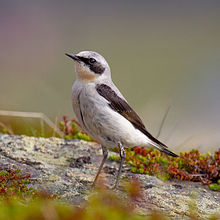Northern wheatear
| Northern wheatear | |
|---|---|
 |
|
| Male in breeding-plumage | |
| Scientific classification | |
| Kingdom: | Animalia |
| Phylum: | Chordata |
| Class: | Aves |
| Order: | Passeriformes |
| Family: | Muscicapidae |
| Genus: | Oenanthe |
| Species: | O. oenanthe |
| Binomial name | |
|
Oenanthe oenanthe (Linnaeus, 1758) |
|
The northern wheatear or wheatear (Oenanthe oenanthe) is a small passerine bird that was formerly classed as a member of the thrush family Turdidae, but is now more generally considered to be an Old World flycatcher, Muscicapidae. It is the most widespread member of the wheatear genus Oenanthe in Europe and Asia.
The northern wheatear is a migratory insectivorous species breeding in open stony country in Europe and Asia with footholds in northeastern Canada and Greenland as well as in northwestern Canada and Alaska. It nests in rock crevices and rabbit burrows. All birds spend most of their winter in Africa.
This species was first described by Linnaeus in his Systema naturae in 1758 as Motacilla oenanthe. The generic name, Oenanthe, is also the name of a plant genus, the water dropworts, and is derived from the Greek ainos "wine" and anthos "flower", from the wine-like scent of the flowers. In the case of the wheatear, it refers to these birds' return to Greece in the spring just as the grapevines blossom.
Its English name has nothing to do with wheat or ears, but is an altered (perhaps bowdlerised) form of white-arse, which refers to its prominent white rump.
The following are the subspecies of northern wheatear:
The northern wheatear is larger than the European robin at 14½–16 cm length. Both sexes have a white rump and tail, with a black inverted T-pattern at the end of the tail.
...
Wikipedia

